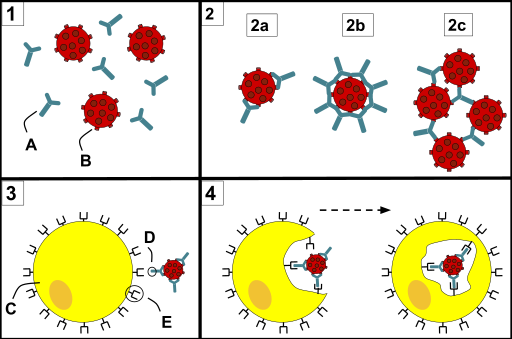Antibody_Opsonization.svg

Size of this PNG preview of this SVG file:
512 × 339 pixels
.
Other resolutions:
320 × 212 pixels
|
640 × 424 pixels
|
1,024 × 678 pixels
|
1,280 × 848 pixels
|
2,560 × 1,695 pixels
.
Summary
| Description Antibody Opsonization.svg |
English:
1) Antibodies (A) and pathogens (B) free roam in the blood. 2) The antibodies bind to pathogens, and can do so in different formations such as: opsonization (2a), neutralisation (2b), and agglutination (2c). 3) A phagocyte (C) approaches the pathogen, and the Fc region (D) of the antibody binds to one of the Fc receptors (E) of the phagocyte. 4) Phagocytosis occurs as the pathogen is ingested.
Español:
1) Los anticuerpos (A) y los patógenos (B) vagan libremente por la sangre. 2) Los anticuerpos se unen a los patógenos y pueden hacerlo mediante diferentes formaciones tales como: opsonización (2a), neutralización (2b), y aglutinación (2c). 3) Un fagocito (C) se aproxima al patógeno y la región Fc (D) del anticuerpo se une a uno de los receptores Fc (E) del fagocito. 4) Por último, tiene lugar la fagocitosis a medida que se ingiere el patógeno.
|
| Date | |
| Source | Own work |
| Author | Maher33 |
Licensing
I, the copyright holder of this work, hereby publish it under the following license:
This file is licensed under the
Creative Commons
Attribution-Share Alike 4.0 International
license.
-
You are free:
- to share – to copy, distribute and transmit the work
- to remix – to adapt the work
-
Under the following conditions:
- attribution – You must give appropriate credit, provide a link to the license, and indicate if changes were made. You may do so in any reasonable manner, but not in any way that suggests the licensor endorses you or your use.
- share alike – If you remix, transform, or build upon the material, you must distribute your contributions under the same or compatible license as the original.
Captions
Add a one-line explanation of what this file represents
